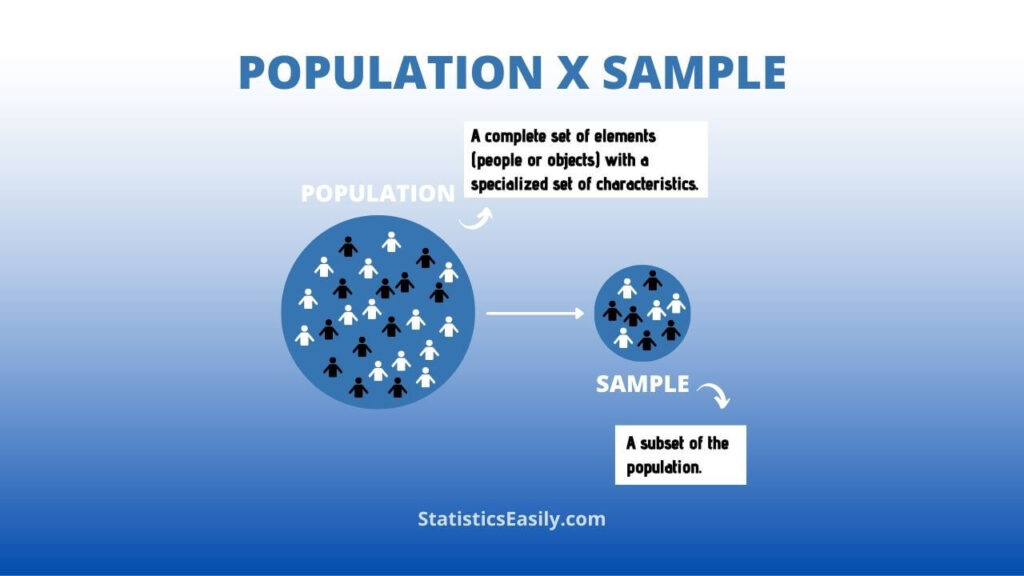What is the Difference Between the Sample and the Population?
In statistics, a population is an entire group that is the focus of a study — a sample is a subset of that population.
Introduction
Statistics, an integral branch of mathematics, is essential in various fields. It aids in data collection, analysis, interpretation, presentation, and organization. This article will specifically delve into two critical terms in statistics: Sample and Population. Knowing the distinction between them is crucial for correct data analysis and making informed decisions.

Highlights
- Statistics aids in data collection, analysis, interpretation, and organization.
- A population is an entire group about which some information is required.
- Populations in data analysis are often large and sometimes even infinite.
- A sample is a part of a population selected to gain information about the population.
- Sampling provides a manageable way to gather data quickly and cost-effectively.
Ad Title
Ad description. Lorem ipsum dolor sit amet, consectetur adipiscing elit.
Understanding Population in Statistics
In statistical terms, a population is an entire group about which some information is required. This group can be of any size and does not necessarily need to be people. It can be a population of animals, a population of product units, a population of case files, etc. For example, if a clothing brand wants to study the average spending of customers on its products, the entire customer base would be the population.
Understanding the concept of population is crucial. It forms the basis of any statistical study. In real-world data analysis, populations are often large and sometimes infinite. Therefore, obtaining information from the entire population can be time-consuming and costly, which leads us to the concept of a sample.
Understanding Sample in Statistics
A sample is a part of a population. It comprises some members selected from the population. Sampling aims to gain information about the population without having to study everyone. For instance, if the clothing brand mentioned earlier decides to survey 1000 of its customers, those 1000 customers constitute a sample.
Samples hold great significance in statistical analysis. They provide a manageable way to gather data quickly and cost-effectively. Furthermore, a sample can accurately represent the population if chosen correctly, making data analysis applicable to the larger group.
Comparison Between Sample and Population
There are key differences and similarities between a sample and a population. A population includes all members of a defined group, while a sample consists of a portion of that population. Yet, a well-chosen sample should ideally represent the characteristics of its population. That said, there are always chances of sampling error, meaning the sample’s characteristics might not perfectly represent those of the population.
When selecting a sample from a population, various criteria are considered. These include the study’s purpose, the population’s nature, and the available resources. The purpose is to select a sample that best represents the population’s characteristics, minimizes bias, and maximizes the accuracy of extrapolations made from the sample to the population.
Understanding the difference between them is foundational in statistics and data analysis. It helps in the accurate interpretation of data and in making informed decisions. Whether you’re a student, a researcher, a business professional, or a lifelong learner, gaining a firm grasp on these concepts will undoubtedly serve you well in the age of information and data.
Ad Title
Ad description. Lorem ipsum dolor sit amet, consectetur adipiscing elit.
Recommended Articles
If you found this article valuable, we recommend checking out our other articles on similar topics to gain a more in-depth understanding of statistics and data science.
- Understanding Random Sampling: Essential Techniques in Data Analysis
- Understanding Sampling Error: A Foundation in Statistical Analysis
- Unraveling Sampling Bias: A Comprehensive Guide
- Random Sampling on Excel: An In-depth Analysis
- Understanding Random Sampling (Story)
- Population – an overview (External Link)
- Unraveling Sampling Bias (Story)
Frequently Asked Questions (FAQs)
A population is an entire group about which some information is required.
Yes, populations in data analysis can often be large and sometimes even infinite.
A sample is a part of a population selected to gain information about the population.
Sampling aims to gain information about the population without having to study everyone.
A well-chosen sample should describe the characteristics of its population. However, there’s always a chance of sampling error.
Sampling error is the chance that a sample might not perfectly represent the population.
Sample selection depends on the study purpose, the nature of the population, and available resources.
Sampling aims to minimize bias and maximize the accuracy of extrapolations made to the population.
Understanding the difference between sample and population is foundational in statistics and data analysis for accurate data interpretation and informed decision-making.
Statistics is applied in various fields such as science, business, education, healthcare, and more for data collection, analysis, and interpretation.








